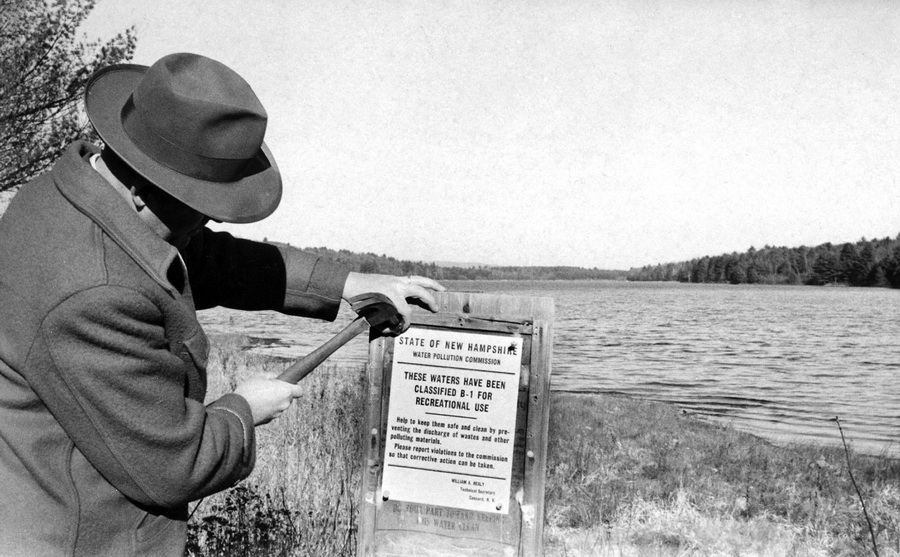Work Begun in the 1940s Continues to Guide Efforts for Clean Water
by Michelle St. John and Adam Auster
Today NEIWPCC and its program partners perform or fund extensive environmental monitoring and restoration. The Commission’s staff coordinates training for thousands of wastewater operators in the Northeast. States have well-staffed environmental and health departments, and the U.S. EPA regulates work to meet state obligations under the Clean Water Act.
None of that was true in the period immediately after World War II, when Congress authorized, and states ratified, the compact for the New England Interstate Water Pollution Control Commission. The Commission’s early work classifying water bodies and setting standards for those classifications provided the basis for everything that followed.
The mood of the country was confident in 1947, when the three members of the new Commission met for the first time. At that meeting, the Commission appointed four scientists and engineers to what would become known as the Technical Advisory Board, or TAB.
Interstate waters need coordinated efforts to ensure that what is discharged upstream in one jurisdiction is safe for those downstream. In the Northeast, many significant watersheds cross state lines.
While the Commissioners, appointed by their respective Governors, provided political oversight, it was the TAB that dug into the details. Should the Androscoggin be suitable for fishing? What are the actual tests a water body would have to meet to be considered fishable, or swimmable, or a fit source of drinking water?
In doing this work, these bodies provided the technical basis for everything that followed—although real progress would wait for the direct involvement of the federal government, starting in the 1970s.
In the 1930s, the National Resources Planning Board (1933–1946), a New Deal agency, had begun work on some of the technical questions. This early effort was the foundation for the first set of standards and classifications approved by the Commission in April 1948, just six months after its first meeting.
A review of archival correspondence indicates this was not an easy feat, as the Technical Advisory Board discussed minute details at several meetings and conducted and reviewed considerable correspondence with TAB members representing the member states of Connecticut, Massachusetts, and Rhode Island and those states yet to ratify the compact—Maine, New Hampshire, New York, and Vermont.
Standards and Classifications
What did the early water-use classifications and quality standards look like? The first iteration fit on a single page. Today, standards across the region fill close to two dozen pages and comprise EPA guidance and standards by individual state.
The water use classifications ranged from “A” (suitable for public water supply, “character uniformly excellent”) to “D” (suitable for transportation of sewage and industrial wastes without nuisance, and for power, navigation and other industrial uses). Early standard measures included acceptable levels of dissolved oxygen, oil and grease, odor, scum, floating solids, sludge deposits, coliform bacteria and more.
Early parameters were broad. Over the seven iterations between 1947 and 1973, parameters become much more restrictive, refining criteria as technology and technique evolved and developed.
To accommodate those states not yet formal members of the compact, the first set of standards for bacteria was intentionally lax. Later, as states joined NEIWPCC and engaged in the standards-setting process, they agreed to a bacteria standard that was more exacting.
Notable changes were the addition of phenol (1948) and radiation (1959); the addition of a Technical Appendix and Guidelines (1966), separate classifications and standards for marine waters (1967), and policy and guidelines (1967).
After the Water Quality Act of 1965 changed how standards are set, approved, and enforced, states started to write their own. States also began the process of reorganizing disparate boards and commissions into unified environmental agencies.
The Basis to Act
When the states built their technical capacity in water-pollution issues, and when the federal government joined the states in a significant way, NEIWPCC and its Technical Advisory Board had already laid the foundation for action.
When Congress made funds available to clean up lakes, rivers, and seashores by building new wastewater treatment plants, the construction furthered the standards and classifications established, originally, by the Commission. When NEIWPCC launched its program to professionalize the wastewater field, and to train a professional workforce, it did so in service to those same standards and goals.
Today, the Commission’s workgroups and staff have taken up the TAB’s role as a source of technical guidance for water issues. Where once NEIWPCC wrote water-quality standards, today it convenes a Water Quality Standards workgroup to share expertise and explore current issues in standards.
The workgroup comprises key state and federal employees. At its most recent meeting, the group learned about a new tool for determining copper criteria for estuarine waters, and discussed the work in each state to prepare the water-quality reports that the Clean Water Act requires every two years.
The workgroup is an example of what NEIWPCC does best: bringing the states together to discuss current issues and trends in water quality, and to learn about new assessment tools. The goal is to help states improve bodies of water that do not meet current water quality standards.
This work would be at once new and familiar to the members of the original Technical Advisory Board.
Michelle St. John is an Information Officer at NEIWPCC. Adam Auster is NEIWPCC’s Director of Communications.
This story is available as a reprint, one of a series from NEIWPCC. It was originally published in the September, 2017, issue of Interstate Waters.
